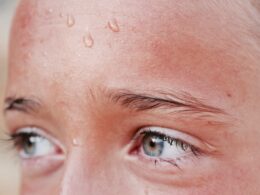Whether caused by shaving, waxing, or plucking, ingrown hairs can be painful and uncomfortable. Avoid scratching or digging at the bumps as this can introduce bacteria and lead to infection.
Gently washing the area and applying a warm compress can help bring the ingrown hair to the surface so it can be plucked out with clean, sterilized tweezers.
Wash the Area
Fortunately, most ingrown hairs are harmless and will resolve on their own. However, when hairs become trapped underneath the skin, they develop into painful pink bumps and can cause itching. Gently washing and exfoliating the area can help to guide the hair back to the surface, but it is important not to scratch at the area because that could introduce bacteria and lead to an infection.
A person can use a washcloth or loofah to gently scrub the area around the ingrown hair on the vagina and remove any dirt, oil or dead skin cells that may be stuck – This section is the result of the service experts’ research sexy-belle.com. However, the genital area is delicate and using a scrub or a loofah can disrupt the balance of the intimate skin. Instead, a doctor may recommend that a patient use an exfoliant such as a retinol or salicylic acid product.
Another way to help with a painful ingrown hair on the vagina is to apply a warm compress. A person can run a clean washcloth under hot water and press it against the area for several minutes to soften the hairs and the surrounding skin. This will also make it easier to pull out the ingrown hairs with a pair of sterilized tweezers.
An ingrown hair on the vagina is sometimes caused by poor hygiene, especially when it comes to wearing tight-fitting undergarments. This can cause the genital area to rub against clothing, which can disturb the hair follicles and cause them to grow inward. Some medical conditions, such as diabetes or a low immune system, can also increase the risk of ingrown hairs.
Apply Ointment
Many people choose to trim, wax, or shave their pubic hair, while others leave it alone. If you decide to remove unwanted pubic hair, it’s important to properly wash and prepare the area before shaving. This helps reduce the risk of ingrown hairs. Gently washing the area, using a warm compress, and applying an ointment can help hair return to its natural position above the skin’s surface. It’s also important to avoid squeezing or picking at the hair, which can cause scarring and lead to infection.
Instead, a doctor recommends gently washing and exfoliating the area. He or she may prescribe products that are specially formulated for the genital area to lubricate the hair and help it grow back correctly. These products are often available over-the-counter and include ingredients like glycolic acid or salicylic acid, which keep hair follicles open and prevent them from getting trapped.
While most ingrown hairs on the groin resolve on their own, it’s important to see a physician if the bumps become painful or swollen, especially if they ooze pus. According to ob-gyns, if you see these signs, it could mean the hair is infected and needs treatment. An ointment can provide relief by soothing the skin, while antibiotics can treat an infection. The ointment should be applied to the ingrown hairs every two to three hours.
Warm Compress
Most ingrown hairs that develop in the vulva will grow back through the surface of the skin without causing pain or itching. But some hairs curl back into the follicle and become trapped underneath. This triggers the body’s response to the hair as a foreign object, and symptoms such as itching, redness, and swelling occur. Scratching or digging at the ingrown hair can introduce bacteria into the area, cause a skin infection, and leave a scar.
A few simple steps can help prevent a person from developing ingrown hairs in the vulva. Washing with a fragrance-free soap and using shaving cream or gel designed for the sensitive area can soften hair and reduce the likelihood of it growing back into the follicles. Products containing glycolic or salicylic acid can also help keep the hair follicles open so they don’t get trapped.
People with recurring ingrown hairs should also stop shaving, waxing, and plucking the area, since these treatments can further irritate the genital area. If a person suspects she has an ingrown hair that’s infected, she should contact a doctor, who can prescribe ointments and oral antibiotics.
Vaginal boils can be very painful, and some women have a tendency to develop multiple boils in the vulva. These are actually bacterial infections that start out as small pus-filled bumps but can grow to the size of a golf ball or more. They are often accompanied by soreness, tenderness, and inflamed lymph nodes in the groin. A doctor can usually diagnose a boil by examining the vulva or collecting a sample of the drainage to see what kind of bacteria is present.
Tweeze
Although it’s tempting to reach for a tweezer when you see an ingrown hair on your vulva, resist the urge. Ingrown hairs are painful enough, but pulling at them can cause an infection. Instead, use sterilized tweezers to carefully remove the hair from its root and the skin around it.
The most common causes of ingrown hairs are shaving and waxing, but they can also develop from tight-fitting clothing, tweezing, or even a pimple. They can also happen when hair grows back in the wrong direction and enters a nearby hair follicle, leading to inflammation of the area.
Some people are more prone to having ingrown hairs in the genital area than others, Dr Dweck says. This is because hair in this area tends to be more coarse and curly than the rest of the body’s hair.
If you’re prone to them, make sure to use a fresh razor when you shave the area. Also, don’t use the same razor on your armpits or legs that you use on your vulva, she notes. An old, dull razor can harbor bacteria that can lead to an infection.
Most ingrown hairs clear up on their own, but it’s best to talk to your doctor if one is especially persistent or looks infected, she adds. If your ingrown hair is painful to the touch or oozes pus, you may need antibiotics to treat it.









